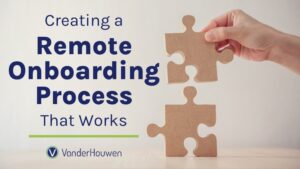9 Tips for a Seamless Onboarding Process
The hiring market is in a frenzy. More jobs are posted than there are candidates to fill them. Now, it is more important than ever to ensure your new employee’s first impression is a great one. This is where a strong and effective onboarding process is key to making your company stand out.
In most cases, the onboarding process serves as your company’s chance to welcome new hires, showcase what your company is all about, and really solidify the decision a new employee made in joining the team. Making your onboarding process a seamless experience is key to alleviating stressors for both the hiring team and employees by creating a positive and productive environment the first day, week, and even month of a new employee’s tenure at your company. When the process is simple and steady, a new hire can focus on what’s needed to come in day one and hit the ground running.
When it comes to creating a best-in-class onboarding process, the most important thing to remember is consistency. Having a reliable, efficient, and actionable communication and documentation process helps your new employees feel comfortable and confident in your organization right away. Here are nine tips for ensuring the onboarding of a new employee is consistent, streamlined, effective, and builds excitement throughout the process.
We’ve seen many companies provide gifts like Amazon gift cards to help someone set-up their new workstation or Visa gift cards to give the new employee the opportunity to explore great cafes and lunch spots near the office. Showing your new team that you are excited to invest in them now and in the future will make them feel at ease and at home in your organization from the get-go.
Quality work product is only a sign of a quality employee—it is not usually an accurate gauge of a person’s overall mental health and happiness in the workplace. As a manager, it’s your job to consistently keep track of how your new employees are doing and feeling, both in their job duties and workload as well as in overall company culture and team fit. From an HR standpoint, this is a time to build trust and open lines of communication as well as lay the groundwork for future communication that impacts the success of your team.
After spending considerable time and money to recruit the perfect fit for an open position, it is easy to take a breath and relax and feel like your job is done. In reality, that couldn’t be further from the truth, especially in today’s job market. Onboarding starts at the moment your new employee signs their offer letter. Make a positive, lasting impression on your new employees by being prepared, communicating consistently, and reviewing and updating your onboarding program constantly—your new employees will thank you!
In most cases, the onboarding process serves as your company’s chance to welcome new hires, showcase what your company is all about, and really solidify the decision a new employee made in joining the team. Making your onboarding process a seamless experience is key to alleviating stressors for both the hiring team and employees by creating a positive and productive environment the first day, week, and even month of a new employee’s tenure at your company. When the process is simple and steady, a new hire can focus on what’s needed to come in day one and hit the ground running.
When it comes to creating a best-in-class onboarding process, the most important thing to remember is consistency. Having a reliable, efficient, and actionable communication and documentation process helps your new employees feel comfortable and confident in your organization right away. Here are nine tips for ensuring the onboarding of a new employee is consistent, streamlined, effective, and builds excitement throughout the process.
1. Create a schedule.
Having your new employee’s first day outlined and organized is a critical piece of successful onboarding programs. Show your new hire that you have their best interest in mind by being prepared and on time to welcome them at the door. Give your new employee a sense of comfort and certainty by documenting their first day schedule including the who, what, where and when of meetings and activities. Make sure your colleagues know where and how they’re involved in the onboarding process by communicating the plan with them beforehand and scheduling time on their calendars when appropriate. Build in extra time in their schedules where needed to allow for warm introductions and friendly conversation without the rush of meeting a deadline.2. Make sure your office is ready.
Creating a warm and welcoming office environment is a great way to start your relationship with your new employees on the right foot. Make sure a computer is prepared, any technology is set up, and a clean desk is ready to go prior to their first day. Believe us, it’s far better to have a desk and computer set up a week early than four hours late! Last minute scrambling can show a lack of care, attention to detail, and potentially a systemic problem within the organization. Leave a positive and lasting impression by bringing a new hire into a properly configured workstation that allows them to perform to their best ability.3. Show off!
Onboarding is your time as the hiring manager show off all the great things your company, your department, and what your teams are doing. Highlight what makes your company unique and why you love working there. If this is an office role and you have manufacturing onsite, put on the hard hat and familiarize the new hire with all aspects of the company. This is the chance for your new employee to really get to know what working at your organization is like, so no aspect of the company should be off limits!4. Get a gift.
A common practice these days is welcoming your new employee with company-branded swag, tools, or gifts. Considering adding a gift into your onboarding package? Remember, it doesn’t have to be expensive or elaborate—instead make a point to consider items that an employee will be proud to have and will definitely use, such as comfortable gear with your company’s logo, branded office supplies, or something personalized to show you are excited to have them.We’ve seen many companies provide gifts like Amazon gift cards to help someone set-up their new workstation or Visa gift cards to give the new employee the opportunity to explore great cafes and lunch spots near the office. Showing your new team that you are excited to invest in them now and in the future will make them feel at ease and at home in your organization from the get-go.
5. Clearly define their path to success.
Setting clear and reasonable expectations for both short- and long-term success is critical to ensuring you and your new hire are aligned and heading in the same direction. Take the time to discuss all aspects of their career path and success plan and answer their questions. This will set a precedent and define the framework for future conversations surrounding performance, potential promotions, and/or future pay increases. By avoiding any confusion and misunderstanding in the early stages of a new employee’s tenure, you will begin to build a strong foundation for a long and mutually beneficial partnership.6. Leave no question unanswered.
Though obvious, encouraging your new employees to ask any and all questions is very important, and often overlooked, part of the onboarding process. Welcome questions from your new employees as they have them and encourage them to seek out the appropriate people to get answers to at any point. Give them the tools needed to succeed by providing a sheet of company contacts with their areas of expertise. By arming your new hire with names and contact information of those most likely to have answers, you are helping to create a sense of acceptance for asking questions as well as fostering a team/company identity of open communication.7. Consistently revisit your onboarding process.
Hiring is an ever-evolving process and employee needs are changing at a more rapid pace than ever before. As new generations enter the job market, what you’ve always done may no longer be relevant. To keep your process up-to-date, constantly and consistently review your onboarding strategies. Being open to honest feedback from all parties helps ensure that your program is consistent, streamlined, effective, and most importantly welcoming of a new hire to your team. Ask for reviews and constructive criticism from your team and new employees. Take a close look at every aspect of the process and address your team’s pain points by re-tooling your process as needed.8. Ask for feedback beyond the onboarding process.
Onboarding is a great opportunity to not only learn from new hires what’s working and what’s not in your onboarding process, but to learn about your team, your division, and your company as a whole from a fresh set of eyes. Are there issues that you’ve become blind to? Areas for improvement that you haven’t noticed yet? Ask your new employees for feedback on their challenges in the company or any gaps they see. Being able to look at your company from a new angle is an incredibly valuable opportunity that shouldn’t be missed.9. Understand that onboarding goes beyond the first week.
Onboarding doesn’t end after day one or week one. For many organizations, it is very easy, especially in busy times, to get a great new employee and let them run. But as a manager, it’s key to remember that this is the critical time when new employee onboarding turns quickly into employee retention. Make time to check in with your new employees regularly to continue their onboarding, from both a managerial aspect as well as an HR presence.Quality work product is only a sign of a quality employee—it is not usually an accurate gauge of a person’s overall mental health and happiness in the workplace. As a manager, it’s your job to consistently keep track of how your new employees are doing and feeling, both in their job duties and workload as well as in overall company culture and team fit. From an HR standpoint, this is a time to build trust and open lines of communication as well as lay the groundwork for future communication that impacts the success of your team.
After spending considerable time and money to recruit the perfect fit for an open position, it is easy to take a breath and relax and feel like your job is done. In reality, that couldn’t be further from the truth, especially in today’s job market. Onboarding starts at the moment your new employee signs their offer letter. Make a positive, lasting impression on your new employees by being prepared, communicating consistently, and reviewing and updating your onboarding program constantly—your new employees will thank you!
Not sure how to onboard remote employees? Read this for our tips to making a remote onboarding process that works.































































































































